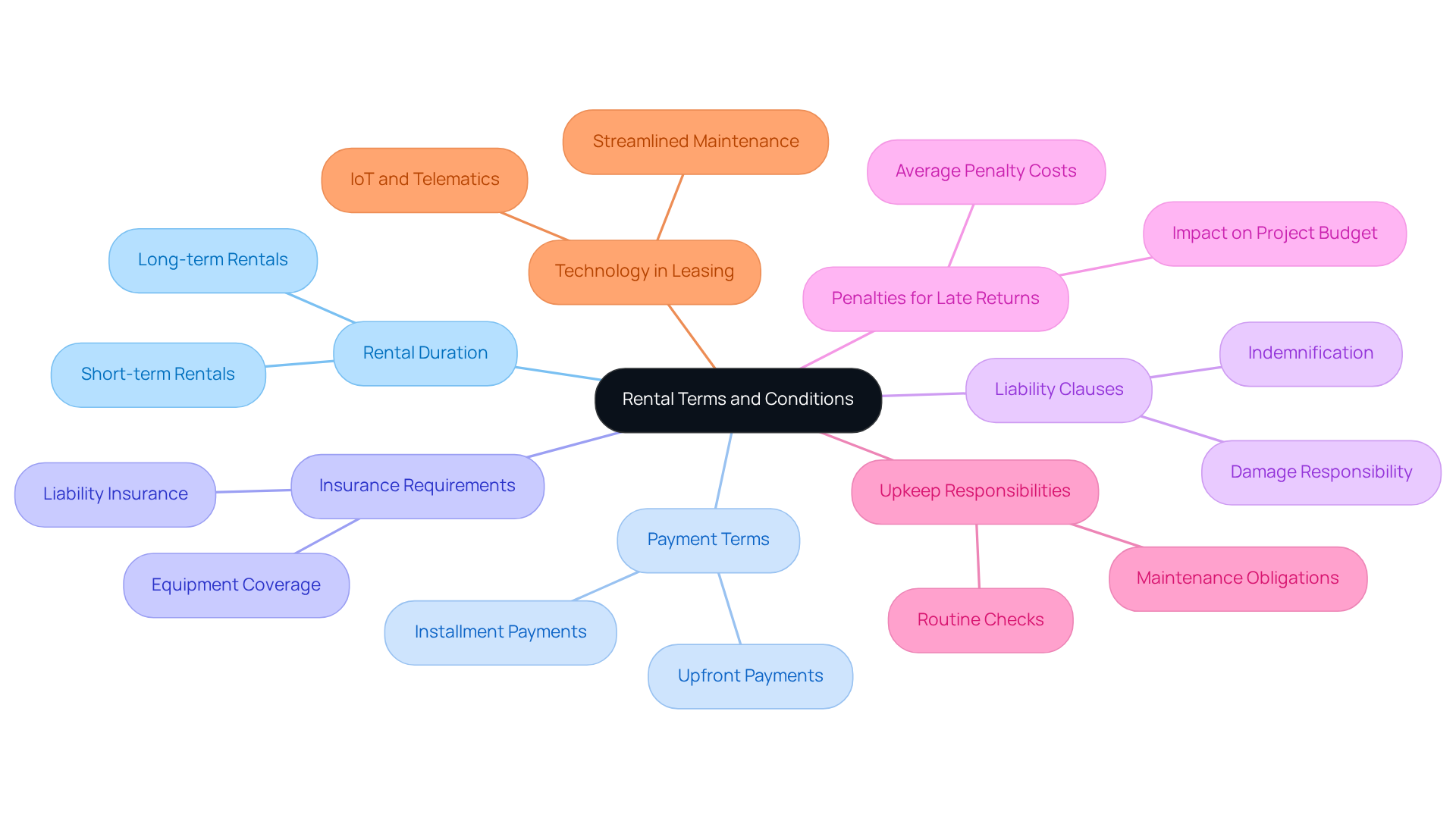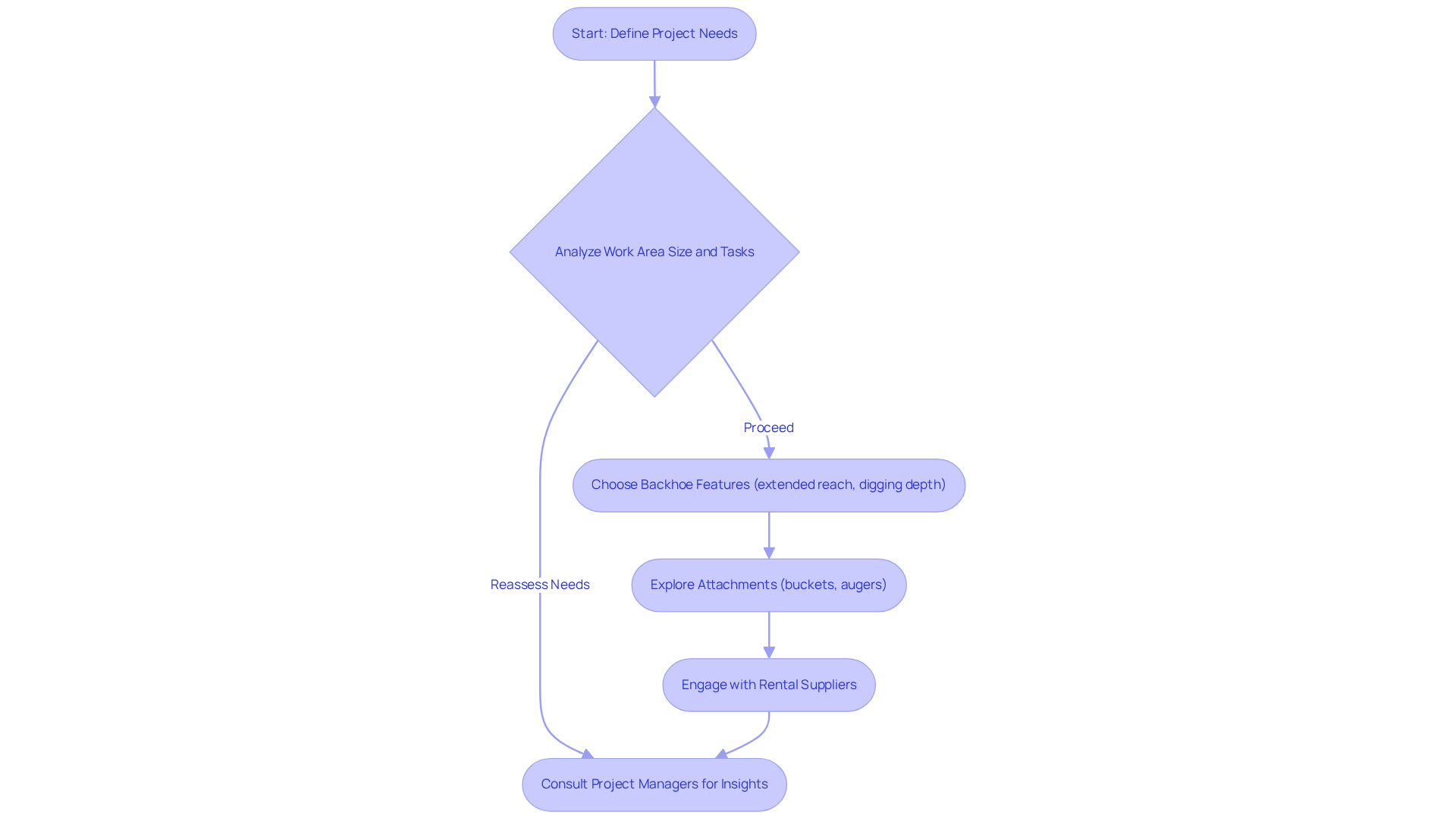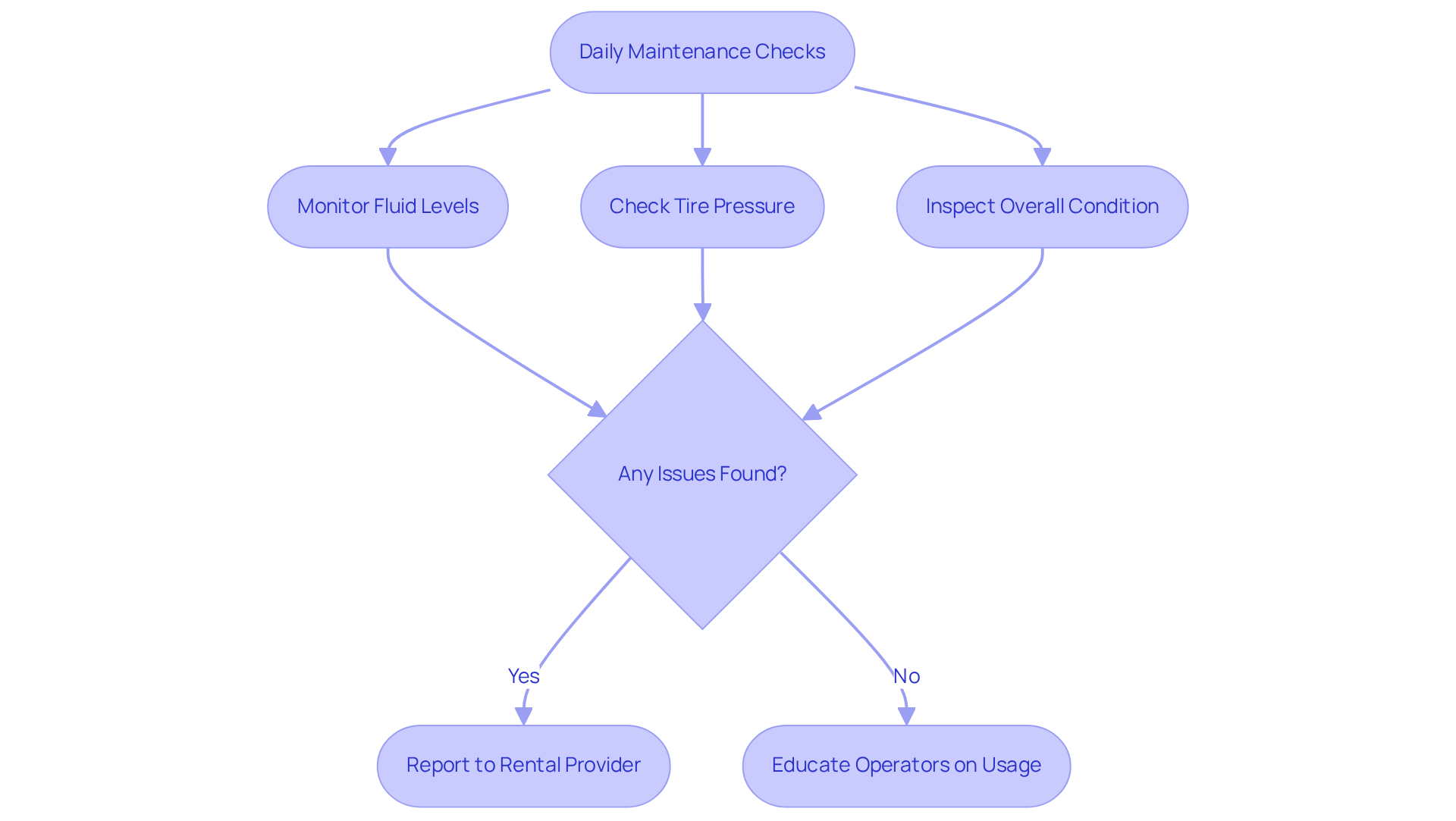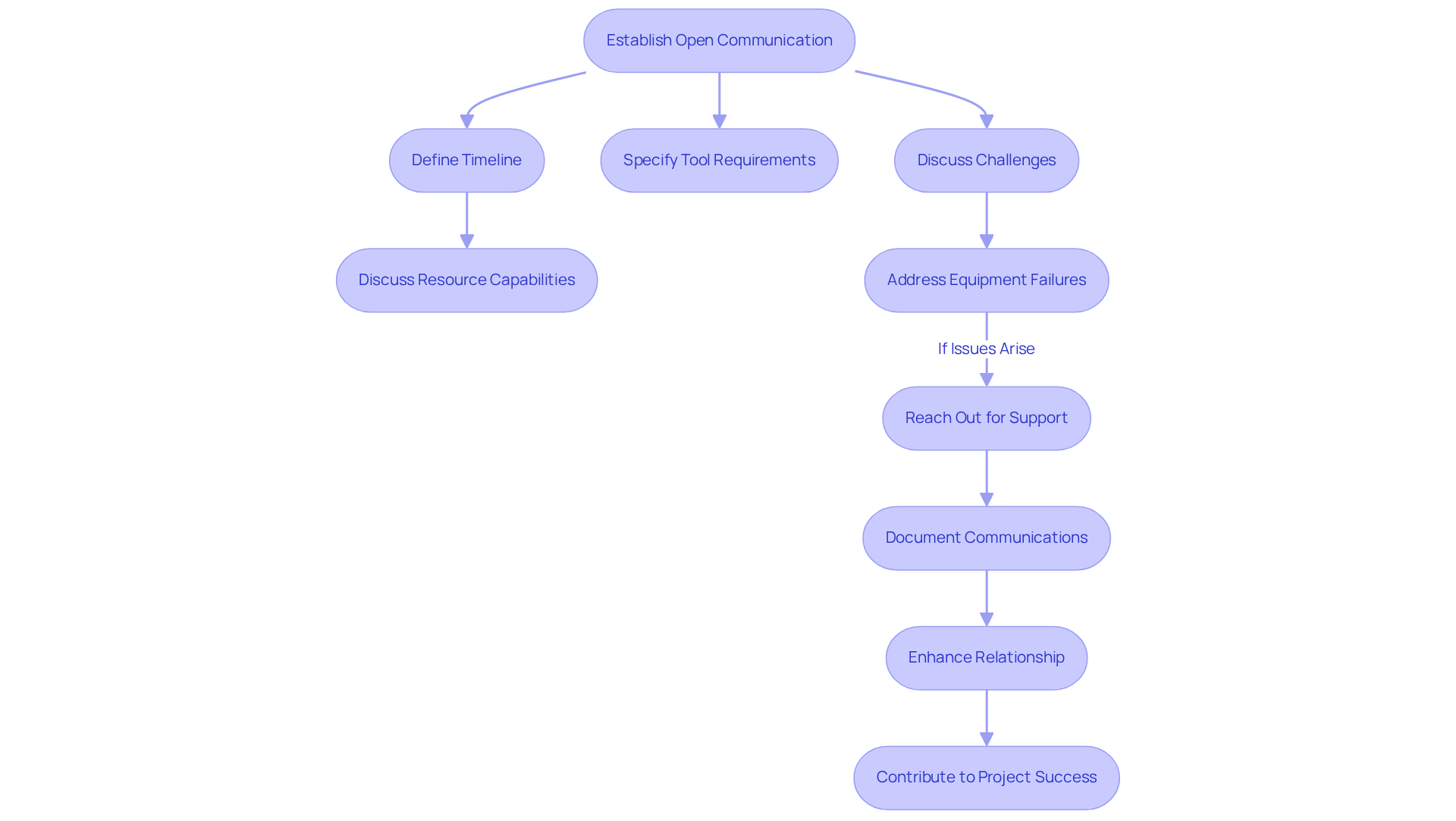Overview
Key strategies for achieving success in backhoe equipment rental encompass:
- A thorough review of rental agreements
- Careful selection of the appropriate backhoe for specific project needs
- Strict adherence to maintenance guidelines
- Effective communication with rental providers
Understanding rental terms is crucial to avoid unexpected costs, ensuring that projects remain within budget. Moreover, selecting the right equipment significantly enhances performance, leading to greater efficiency on the job site. Clear communication with rental providers is essential to meet project timelines and expectations, fostering a collaborative environment that benefits all parties involved.
Key Highlights:
- Thoroughly review rental agreements, focusing on duration, payment terms, insurance, and liability clauses to avoid unexpected costs.
- Understanding penalties for late returns and maintenance responsibilities is crucial for project budgeting and compliance.
- Select the right backhoe by analysing operational needs and considering size, reach, and available attachments to enhance performance.
- The global Backhoe Loader market is projected to grow at a CAGR of 6.07%, emphasising the importance of choosing the right tools.
- Adhere to maintenance guidelines, including daily checks on fluid levels and tyre pressure, to ensure optimal equipment performance.
- Educate operators on proper usage to extend equipment lifespan and minimise wear and tear.
- Establish clear communication with rental providers regarding project timelines and equipment needs to foster a successful partnership.
- Document all communications with rental providers to ensure alignment on agreements and swift resolutions to issues.
Introduction
Navigating the world of backhoe equipment rental can be a daunting task, particularly with the multitude of options and terms that can significantly influence project success. Understanding the intricacies of rental agreements, selecting the right machinery, and maintaining optimal performance are critical elements that streamline operations and reduce costs.
With numerous factors at play, contractors must ask: how can they ensure they make the best choices and avoid common pitfalls in their rental journey? In addition, recognizing the available services and their benefits is essential for informed decision-making.
Understand Rental Terms and Conditions
Before leasing a backhoe equipment rental, it is essential to thoroughly examine the agreement. Focus on key components such as:
- Rental duration
- Payment terms
- Insurance requirements
- Liability clauses
Understanding penalties for late returns or damages is crucial, as these can significantly impact your project budget. For example, average penalties for late equipment returns can vary widely, often leading to unexpected costs that can strain financial resources. According to industry experts, "Leasing services decrease the total cost of ownership with economical leasing options," highlighting the significance of comprehending these contracts.
Furthermore, familiarize yourself with the upkeep responsibilities described in the contract, as these can influence your project's schedule and total expenses. With advancements in technology, such as IoT and telematics, many leasing firms now provide tools that help streamline maintenance processes and reduce downtime. If the leasing firm requires you to perform routine checks, ensure you have the necessary resources and personnel to meet these obligations. A clear understanding of these terms not only helps avoid unexpected fees but also ensures compliance with the backhoe equipment rental company's policies, ultimately contributing to a smoother rental experience.

Select the Right Backhoe for Your Project
Selecting the right backhoe for your project demands careful evaluation of specific operational needs. Begin by analyzing the size of the work area and the tasks you need to accomplish. For instance, if your job requires digging deep trenches, opt for a backhoe that offers an extended reach and greater digging depth. Additionally, explore the range of attachments available, such as buckets or augers, which can significantly enhance the backhoe's functionality and adaptability to various tasks. Engaging with rental suppliers to discuss your requirements for backhoe equipment rental can lead to informed decisions, ensuring you choose a model that enhances performance and productivity on site.
According to industry forecasts, the global Backhoe Loader market is projected to grow at a CAGR of approximately 6.07% over the next eight years, with an anticipated market size of USD 3.46 billion by 2032. This growth underscores the importance of selecting the right tools to meet evolving demands. Furthermore, consulting with seasoned construction project managers can provide valuable insights into common pitfalls in backhoe selection, enabling you to avoid missteps and achieve optimal results for your projects.

Maintain Equipment for Optimal Performance
To ensure optimal performance of backhoe equipment rental, adherence to the maintenance guidelines established by the equipment provider is essential. Daily checks must include:
- Monitoring fluid levels
- Tire pressure
- The overall condition of the machinery
Promptly reporting any issues to the backhoe equipment rental provider is critical to avoid liability for damages. Additionally, educating operators on correct usage and upkeep practices is vital; this not only reduces wear and tear but also enhances equipment longevity. For example, operating backhoe equipment rental within its defined limits can significantly extend its lifespan and minimize the risk of failures during crucial phases.
Industry professionals underscore that regular inspections and strict adherence to maintenance protocols are essential for preventing common issues, which can result in costly downtime. Implementing these strategies not only safeguards the tools but also contributes to the overall success of construction projects in 2025.

Communicate Effectively with Rental Providers
Establishing open lines of communication with your rental provider is essential from the very beginning. Clearly defining your timeline, specific tool requirements, and any expected challenges sets the foundation for a successful partnership. For example, project managers frequently emphasize the importance of discussing resource capabilities and availability to prevent delays. Leasing from a reliable firm like EZ Equipment Rental guarantees access to well-maintained forklifts, as their machinery undergoes regular upkeep, significantly minimizing the chance of failures during crucial operations.
Should problems arise during the leasing period, such as equipment failures or unforeseen delays, it is vital to reach out to the provider immediately to seek swift resolutions. Their team offers comprehensive support, addressing any issues promptly to minimize downtime. Documenting all communications serves as a valuable reference, ensuring that both parties remain aligned on agreements regarding repairs or replacements. A robust relationship with your rental provider not only fosters better service but also enhances support throughout your project, ultimately contributing to its success.

Conclusion
In conclusion, understanding the intricacies of backhoe equipment rental is essential for ensuring project success. By focusing on key strategies—such as comprehending rental terms, selecting the right machinery, maintaining equipment, and fostering effective communication with rental providers—project managers can navigate the complexities of rentals with greater efficiency. These practices not only mitigate risks but also significantly enhance operational productivity.
A thorough examination of rental agreements, careful selection based on project needs, and strict adherence to maintenance protocols are crucial steps that can lead to substantial cost savings and improved project outcomes. Furthermore, establishing a strong rapport with rental providers facilitates timely support and the swift resolution of any issues that may arise during the rental period.
Ultimately, implementing these key strategies empowers contractors and project managers to maximize their backhoe rental experience. By prioritizing informed decision-making and proactive communication, stakeholders can ensure their projects run smoothly and successfully, paving the way for future endeavors in the construction industry.
Frequently Asked Questions
What should I focus on when examining a backhoe equipment rental agreement?
Key components to focus on include rental duration, payment terms, insurance requirements, and liability clauses.
Why is it important to understand penalties for late returns or damages?
Understanding these penalties is crucial as they can significantly impact your project budget, leading to unexpected costs that can strain financial resources.
How do leasing services affect the total cost of ownership?
Leasing services can decrease the total cost of ownership by providing economical leasing options, which can be beneficial for managing project finances.
What should I know about upkeep responsibilities in the rental contract?
Familiarizing yourself with the upkeep responsibilities outlined in the contract is important as they can influence your project's schedule and total expenses.
How can technology assist in the equipment rental process?
Advancements in technology, such as IoT and telematics, allow leasing firms to provide tools that help streamline maintenance processes and reduce downtime.
What should I ensure if the leasing firm requires routine checks?
Ensure you have the necessary resources and personnel to meet these obligations to avoid unexpected fees and ensure compliance with the rental company's policies.




